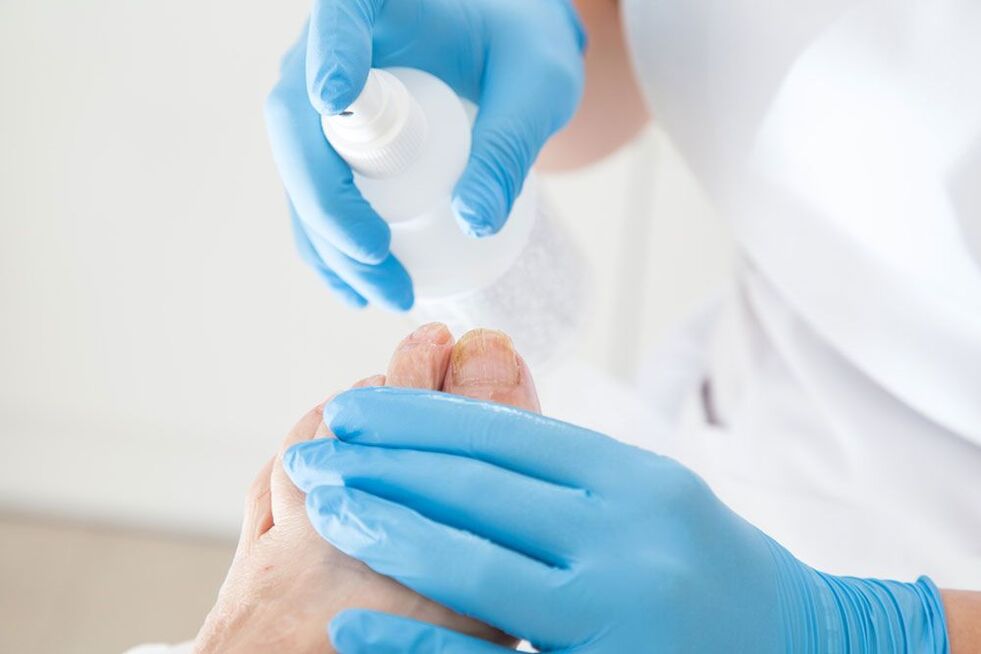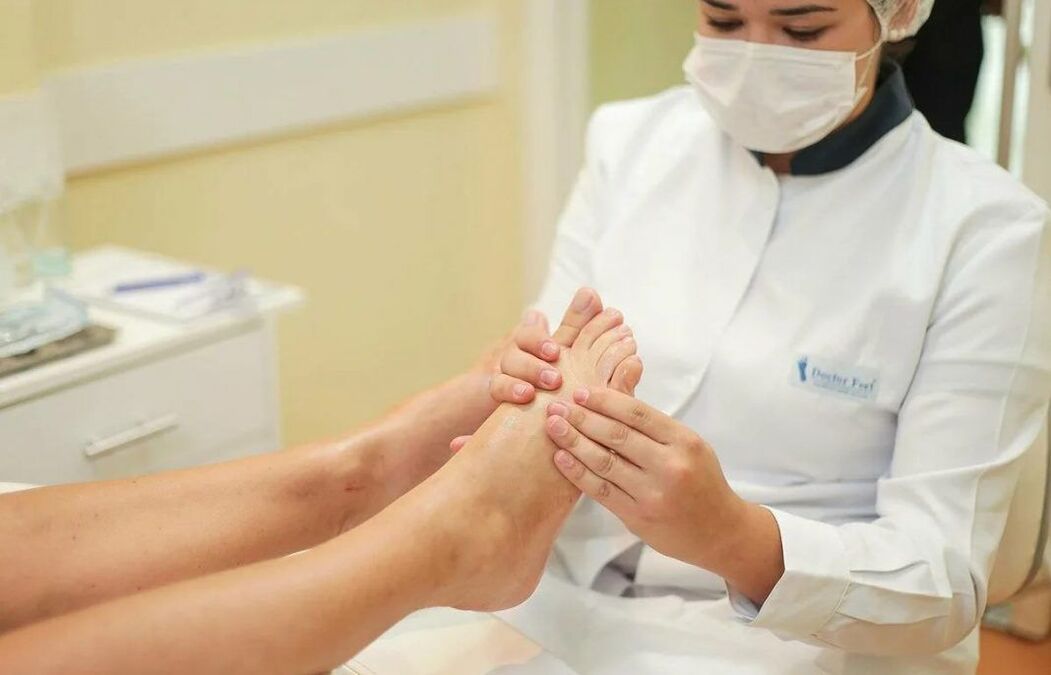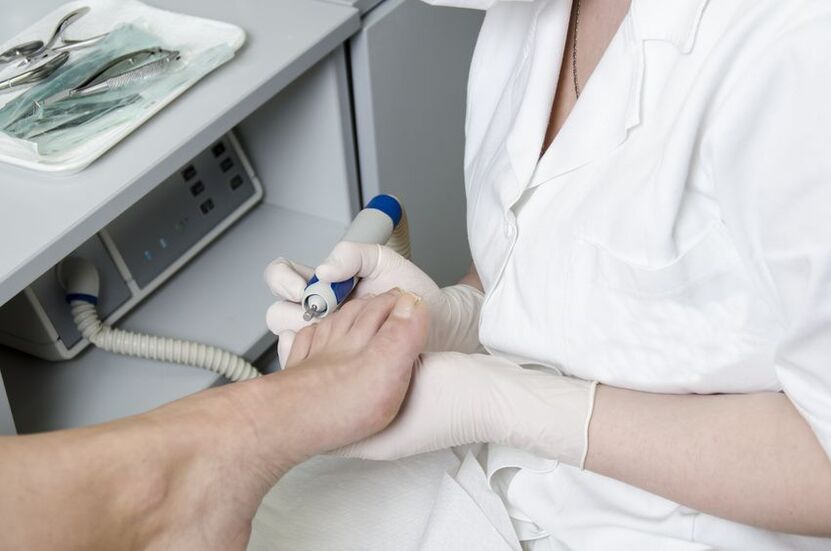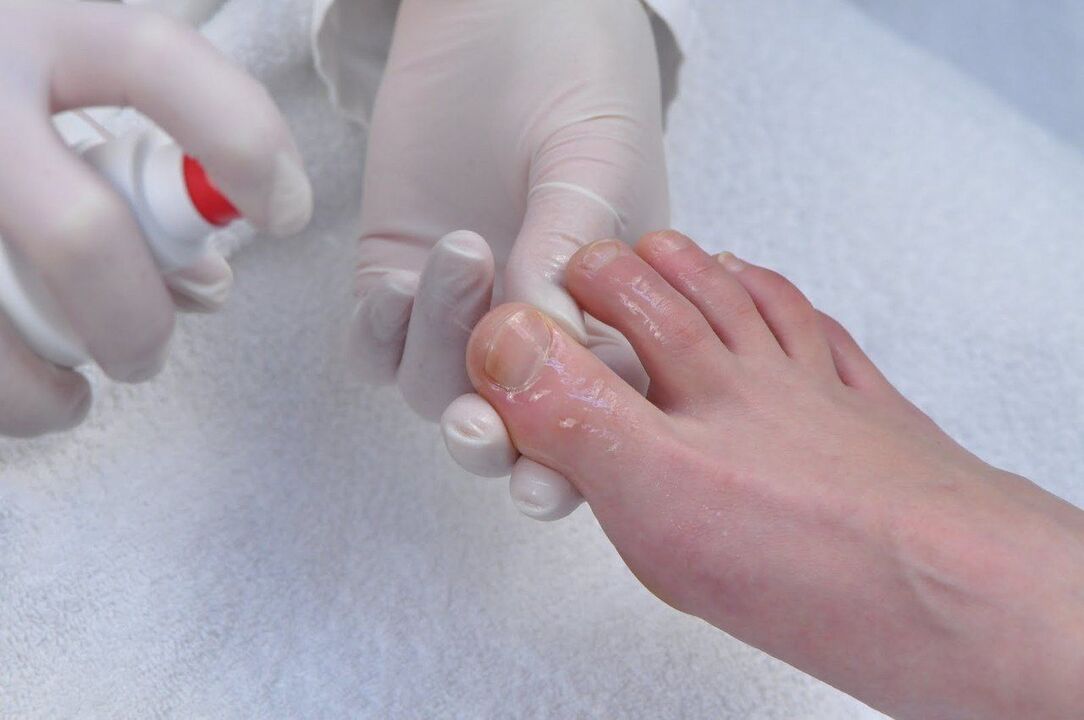Dermatologists and mycologists try not to use formal approaches to the treatment of fungi, which consist of the standard prescription of ointments and tablets and lead to the chronic course of fungal infections and the development of serious complications that reduce the quality of life:
- Fungal eczema.
- Persistent hair loss.
- Nail destruction and nail bed scarring.
- Chronic inflammation of the glans penis and vagina, which constantly disturbs men and women and makes sexual life impossible.
A method of completely getting rid of a fungal disease, which helps to achieve the following goals:
- Destruction of pathogenic fungi in the center of skin lesions.
- Protection of healthy skin (nails, mucous membranes) from the spread of mycosis.
- Relapse prevention.
- Restoration of the normal structure of the skin, hair and mucous membranes while maintaining their elasticity and beauty.
- Removal from the body of waste products of the fungus, which cause chronic intoxication and allergy.
- Restore the sensitivity of the skin and mucous membranes of the genital organs to normalize sexual life.
It would seem that all of this is logical and as it should be. But in practice, dermatologists very rarely adhere to all the rules for the treatment of fungal diseases, often limiting themselves to external therapy. Yes, and many patients just want to "grease something" instead of undergoing a full treatment.
What diseases are treated in the clinic:
- Onychomycosis is a fungal infection of the fingernails and toenails.
- Fungal lesions of the skin of the foot, hand.
- Smooth skin fungus.
- Fungal diseases of the groin folds, axillary, under the mammary glands, intergluteal folds.
- Pityriasis versicolor.
- Scalp fungus, dandruff.
- The fungus that causes seborrheic dermatitis.
- Candidiasis, thrush of the penis and vagina.
- Fungal prostatitis.
- Candidiasis of the oral mucosa and tongue.
- Fungal diseases of the outer ear.
Treatment of the fungus, of course, depends on the type and location of the process. We identify the general phases of therapy:
- Mandatory analysis of scrapings for a fungus with a determination, if possible, of its type, drug sensitivity, quantity.
- Blood, biochemical and immune system tests.
- Removal of the affected area of the nail plate, hair with a laser, hardware or surgically.
- Drug therapy: antifungal drug intravenously or in the form of tablets. It lasts from 10 days to 4 months (with onychomycosis). Injection of antifungals turned out to be the best and allows to reduce the duration of treatment of a fungal disease and reduce the impact on the liver. External treatment with ointments, creams and antifungal solutions in a certain sequence. Preparations that improve the growth of nails, hair, restoring the integumentary epithelium of the skin and mucous membranes. Local treatment in the form of baths on the penis and in the vagina, restoration of the normal microflora of the genitals with a fungal disease of the genital organs. Immunotherapy and removal of fungal toxins and allergens.
- Physiotherapy: ultraviolet irradiation with medical quartz, treatment of the affected areas with infrared laser or ultrasound.
- And in the end - control tests for mushrooms.
Treating fungal diseases can seem too long and complicated. So it is, but only for a doctor! The treatment regimens are designed in such a way that the patient does not notice much discomfort during the therapy and everything goes easily enough for him.
Skin fungus treatment usually takes no time and takes about 10-20 days. The hair and nail treatment is longer and reaches several months.
But it is not even about the duration of the therapy. The treatment of fungal diseases should be carried out by a professional, a dermatovenereologist, a mycologist who is familiar with all the methods listed above and actively applies them in practice. Specialists in this area receive daily in clinics.
Foot fungus treatment
Foot fungus treatment has been carried out together with the therapy of other fungal diseases for more than 13 years.
The method of treatment of the skin fungus of the foot, developed and used in the clinic, has long proved its effectiveness, despite the well-known difficulties in the treatment of fungal diseases.
What patients who have completed a full course with a diagnosis of foot mycosis receive as a result:
- Complete destruction of the pathogenic fungus on the soles of the feet, in the interdigital spaces, on the dorsum of the foot, in the thickness of the nails.
- Elimination of itching and unpleasant odors from the feet.
- Healing of cracks and inflammatory changes in the skin of the foot.
- Restoration of skin elasticity, elimination of hyperkeratosis - thickening of the skin on the sole of the foot, especially in the heel area.
- Elimination of excessive sweating - hyperhidrosis of the feet.
- Growth of healthy nails.

That is, if at the initial appointment, the dermatovenereologist, the mycologist and the patient himself see an image of thickened soles, with cracks, exfoliated epithelium between the toes, congestive redness of the skin of the foot, constantly wet and twisted shoes and socks, nails dark, so after a full course of fungal therapy on the feet, there is a pleasant feeling of comfort in this part of the body, the skin becomes smooth, the smell disappears, the nails are gradually restored.
Stages of treatment for foot fungus
- The diagnostic phase includes the study of skin and nail scrapings for a pathogenic fungus with the determination of the pathogen group, which is important for the choice of an antifungal drug. To complete the picture, information is needed about changes in the patient's metabolism, which can be the main cause of excessive sweating of the skin of the feet and a decrease in local resistance to fungal infections. This is where blood tests help us.
- Treatment of mycosis of the feet itself is carried out in several stages, which depend on the initial clinical picture and the type of fungus. Removal of thick layers of keratinized skin and affected nail areas. This is achieved with the help of special ointments, procedures or hardware and laser removal of pathological areas. The duration of the internship ranges from 1 to 7 days. When the skin has cleared, it becomes possible to use an external antifungal therapy that delivers the drug directly to the skin of the foot.
- Systemic antifungals, i. e. antifungal drugs administered by injection or in tablets. Of course, the intravenous drip of such drugs proved to be more effective. In addition, it was found to be safer for the liver and reduced the duration of treatment, which is 7-14 days for skin lesions, and up to 4 months in combination with nail lesions.
- Physiotherapy treatment of foot fungus includes exposure to medical ultraviolet radiation, which has a detrimental effect on foot fungus, and infrared laser therapy, which further improves blood supply to affected areas, accelerates skin recovery. and nail growth. The duration of the procedure is from 3 to 10 minutes.
- If, as a result of the diagnosis, problems with internal organs, lack of microelements and other substances necessary for the administration of antifungal drugs to the skin, for skin regeneration, to activate the fight against pathogenic fungus are identified, then additional drugs are prescribed auxiliaries for correcting these changes: immunomodulators, ozone therapy, vitamins, hepatoprotectors, iron, calcium and vitamin complexes with microelements.
- Excessive sweating and odor often go away with this foot fungus treatment. But sometimes it is necessary to prescribe drugs that block the sweat glands of the skin of the foot, conduct sessions of laser therapy and cryomassage with liquid nitrogen.
- After treatment, it is necessary to check whether the fungus on the feet has been destroyed. Repeated analyzes of mushroom scrapings are performed. But usually the result is close to 100%.

A very important step in the treatment of foot fungus is the appointment of subsequent relapse prevention, which includes skin care products and the treatment of shoes on which spores of the fungus may remain.
Foot fungus treatment is very diverse. It is impossible to describe all the treatment options in one article. The doctors of the clinic's dermatovenerologists, upon consultation and based on the results of laboratory diagnostics, will be able to determine the most appropriate technique in your particular case of foot skin fungus and conduct a full-fledged treatment.
Nail fungus treatment
Treatment of nail fungus is one of the main areas of clinical work in specialized centers, for the development of which specialists deal in detail with each stage of therapy with onychomycosis.
It has long been known that the treatment of fungal diseases is a serious problem, even more serious than the treatment of bacterial infections. The uncontrolled use of various ointments, tablets, solutions, antifungal paints has led to the growth of a huge number of drug-resistant fungi. And the number of these drugs is very limited, unlike antibiotics. Therefore, in order to get the maximum treatment effect of the patients, we had to use a scientific and practical approach in the treatment of toenail and fingernail fungus and not limit ourselves to the formal prescription of external therapy for the onychomycosis.
What results you will see after a full course:
- Restoration of the color and structure of the nail plate.
- Normalization of the nail growth and its shape.
- The disappearance of the nail fungus, confirmed by the laboratory.
- The unpleasant odor and excessive sweating of the feet will disappear.
- The inflammatory process of the skin of the periungual ridges, interdigital spaces and soles of the feet or palms will go away. That is, the redness, itching, peeling, crying caused by a fungal disease will disappear.
Treatment of nail fungus on the hands lasts 2-3 months, on the legs up to 3-4 months. But everything, of course, is individual and depends on the type of pathogenic fungus, the growth rate of nails in a particular person, the presence of concomitant pathologies of internal organs and blood vessels. For example, in diseases of the veins or arteries of the lower extremities, when the delivery of drugs and nutrients to the nail is interrupted, the treatment time is much longer and the result is very difficult to achieve.
The control of the cure is carried out with a nail fungus after 6 months, with mycosis of the toenails after 1 year.
The clinic employs dermatovenerologists who are trained in all nail removal methods and professionally select the optimal course of therapy for each individual patient diagnosed with nail fungus on the hands and feet.
How nail fungus is treated in the clinic
Nail mycosis is a chronic disease, so the treatment has several stages and is always preceded by a detailed diagnosis that reveals the type of fungus and the possibility of complex treatment, which, unfortunately, cannot be prescribed to everyone.
Stages of treatment for nail fungus:
- Appointment with the mycologist.
- Diagnostics.
- Direct treatment.
At the initial appointment, the doctor will assess the damage to the nails and surrounding skin, if it is also involved in the disease process, as is often the case. He will examine other areas of the skin, mucous membranes, hair, because there are cases when a patient is sent for suspected fungus and in the end the diagnosis sounds like onychodystrophy, that is, the symptoms are similar to the disease, but without an infectious agent. It is associated with metabolic disorders, hormone levels, chronic skin diseases and lesions of the nail matrix and the bed.
Next, a plan of diagnostic measures is drawn up, nail particles and blood are taken for examination.
Diagnosis of onychomycosis of the fingers and toes
| No. | Analyses | Target | Period of execution |
|---|---|---|---|
| one. | Scrape your nails and nail bed for fungus | Determine the type of mushroom to select the most effective drug | 1–3 days |
| 2. | Sowing for mushrooms | Determination of the type of fungus and its sensitivity to antifungal drugs | 7-10 days |
| 3. | PCR diagnostics for Candida | Identification of mycoses caused by yeast-like fungi | 1–2 days |
| 4. | Blood chemistry | Determination of the status of liver and kidney function when planning systemic antifungal therapy. It is also possible to detect metabolic disorders that led to a change in the nails. | 1 day |
| 5. | Hospital complex (syphilis, HIV, hepatitis, coagulogram) | If you are going to remove your fingernails or the affected part of the fingernails | 1 day |
Here is a complete list of the main diagnostic measures, but not all people are assigned all these studies by a mycologist. In the superficial forms, for example, when it is not necessary to remove the plates and prescribe antifungal drugs by mouth or drip, it is not necessary to carry out blood tests.
Cultures are also carried out quite rarely due to their low sensitivity.
Therefore, those treating toenail or fingernail fungus should always consult a dermatologist or mycologist first, then start testing, smearing ointments and drinking pills, and not vice versa.
The correct sampling of material from the affected areas to identify the fungus is also of great importance. Its detection in a particular patient depends on this by 90%. Not only the hard parts of the nail plate are taken for research, but also the loose mass of the nail bed, which contains the maximum amount of the pathogen.
But even with this approach, the lab doesn't always immediately determine the presence of a fungal infection.
With obvious signs of onychomycosis, the analysis is repeated three times with negative results.
Then, the diagnosis was made, the fungus was detected, its type was identified, the condition of the internal organs was examined and therapy began.
Nail fungus treatment by a mycologist

Everything here depends on the clinical situation. The superficial forms of mycosis can be cured by using external agents such as paints, solutions containing drugs that are harmful to fungi and laser processing of plates. Total nail lesions require excision of affected areas and administration of oral or intravenous medications.
We will consider the stages of treatment of an advanced form of toenail fungus, because this is the most difficult stage of onychomycosis to treat with drugs.
Removal of the nail or part of the nail plate affected by the fungus.
As a result, we will immediately rid the body of a huge accumulation of fungi and make the nail bed accessible for the penetration of medicinal substances into it to destroy the microbe that remains there. It also reduces the absorption of fungal waste products into the blood, reducing the allergic and toxic effects on humans.
There are several methods of removing mycosis-affected plaques. The choice depends on the clinical situation and which doctor treats the nail fungus in this patient, which technique he most professionally possesses:
| No. | Methodology | How it takes place | Benefits | Price |
|---|---|---|---|---|
| one. | Hardware nail removal | Used more often. The affected part of the nail plate is sawn with a special cutter at the nail bed and the posterior periungual ridge | Safety Minimal discomfort The patient does not lose working capacity |
1000–1500 rubles |
| 2. | Surgical excision | After the finger conduction anesthesia, the nail plate is removed completely or partially as needed. An antibacterial dressing is applied. | The "cleaner" removal of the affected nail, when the fungus is removed, even from under the nail ridges, the nail bed is cleared of fungal layers. Plastic surgery of a curved nail bed is possible. | From 2500 rubles. |
| 3. | Laser nail removal | Anesthesia of the treated finger is also performed. The laser beam burns the area of the nail affected by the fungus with the capture of the nail bed | Maximum removal of fungal masses, but without penetration under the rear roller | From 3000 rubles. |
The hardware technique is used more often, because it provides a minimum number of complications, does not damage the growth zone and the nail bed, is convenient, but requires more frequent cleaning of the nail bed, as it does not provide complete sanitation of the finger nail bed from the fungus.
After surgical or laser removal, of course, the amount of remaining fungus is minimal, but the duration of the recovery period, possible disability, dressings limit the use of these methods in some patients.
Destruction of the fungus by external means.
On the clean nail bed following the removal of the nail plate, antifungal solutions are applied daily for several months until the growth of a normal nail and a negative analysis for fungi. It is also possible to add antifungal varnishes on the growing edge of the nail plate.
The use of oral and intravenous systemic antifungal drugs. This is the main stage of treatment after nail removal.
It is necessary to ensure the delivery of drugs to the nail matrix, from where a new nail grows, and to the nail bed with blood flow.
Based on the tests, the doctor will select a suitable drug for this patient, as well as the method of administration.
The type of fungus, the condition of the liver and kidneys and the comfort for the patient are taken into account.
For the liver, intravenous administration of drugs that enter the blood and nails, bypassing the intestines and liver, respectively, is the safest.
Treatment is carried out for up to 3-4 months with foot injuries and 2-3 months if the fungus is on the hands.
There are several treatment regimens for nail fungus, which include both daily medications and intermittent courses.
At least once a month, a blood test is performed for liver and kidney indicators. If it deviates from the norm, the treatment is stopped.
- Physiotherapy in the treatment of nail fungus - helps both to destroy the infection and improve drug delivery, accelerate the growth of the nail plate. UV radiation from the nail bed is a detrimental effect on the fungus. 10-15 sessions for 3-5 minutes. Infrared laser: Improvement of blood flow in the area of the growth zone and nail bed, which ensures better administration of drugs in the affected area and acceleration of the growth of a new plate impregnated with antifungal. Antifungal drug electrophoresis is the creation of the highest possible concentration of drugs directly at the heart of the disease process.
- Regular cleaning of the nail bed hardware from layers of hyperkeratosis and fungal residues. For patients with fungal nail diseases, it is important to imagine the entire treatment process and understand that this is a long-term event, the success of which largely depends not only on the doctor treating nail fungus, but also from themselves. It is important to regularly take medications and apply antifungal solutions, treat shoes regularly, adhere to the schedule of physiotherapy procedures and clean the nail bed.
Which doctor treats nail fungus?
Nail fungus is a serious problem. Everyone who has encountered the defeat of nails with mycosis knows this. It is treated for a long time, far from always with a good effect, and the use of various ointments, creams, solutions in almost 95% of cases does not bring any results.
But, in reality, all is not so sad if you know which specialist to contact for nail fungus. And success is also guaranteed when it comes to onychomycosis.
A doctor who treats nail fungus is a mycologist or dermatologist who has experience in managing such patients.
Because experience is important, and not just theoretical knowledge. The fact is that the therapy of a fungal infection affecting the nails lasts more than a month. The result is not immediately visible, it can be very difficult to evaluate its effectiveness. In addition, it is not easy to choose the full range of procedures and drugs for a particular patient, which differ in each clinical situation.

There is a lot of information on the Internet about antifungal drugs, various lasers, methods of physiotherapy and nail removal. Patients, self-medicating, begin to buy one drug after another, and having not received a result, they despair and stop all attempts to get rid of the fungus. The same thing happens when the treatment is prescribed by a doctor who has no experience in monitoring such patients.
The clinic sees a doctor who treats fungi in the legs and arms every day, there is also a fully equipped mycological room, in which all stages of the diagnosis and treatment of onychomycosis are performed.
Which doctor effectively treats nail fungus
- This is necessarily a dermatologist or a mycologist.
- He has experience in examining and treating nail fungus.
- He knows how to remove the affected nail plates, clean the nail bed.
- Knows the stages of systemic therapy of onychomycosis, introduction to the course of physiotherapy methods.
- It can change the tactics of treatment over time or add a procedure, a drug, with a weak effect of the previously prescribed therapy.
- He has the ability to use all modern methods and equipment necessary in the clinic for the treatment of nail fungus.
Treatment of these fungi is a planned, not an emergency, procedure. Therefore, after the examination, the doctor who treats the nail fungus explains to the patient all the options for a possible therapy, but the choice is always up to the person himself.

The course, regardless of the choice of technique, is very long and each patient must understand the effectiveness of each method from the very beginning:
Treatment of nail fungus by external methods (solutions, varnishes, ointments) - the effectiveness is less than 10%, that is, it helps only with the initial and superficial forms.
Using an integrated approach, but without removing the affected areas of the nails, is up to 60% effective.
Complex treatment with removal of the affected part of the nail plate and physiotherapy - efficiency up to 90-95%.
Usually, at the initial appointment, the doctor who treats the nail fungus tells the patient: if patients are ready to undergo a 3-4-month course of complex therapy for onychomycosis, success can be achieved. If not, it's best not to even start. Money, time will be spent and the result will be doubtful. This is a disease that requires a long and pedantic approach in the care of both the doctor and the patient, where even the small details are important.

























